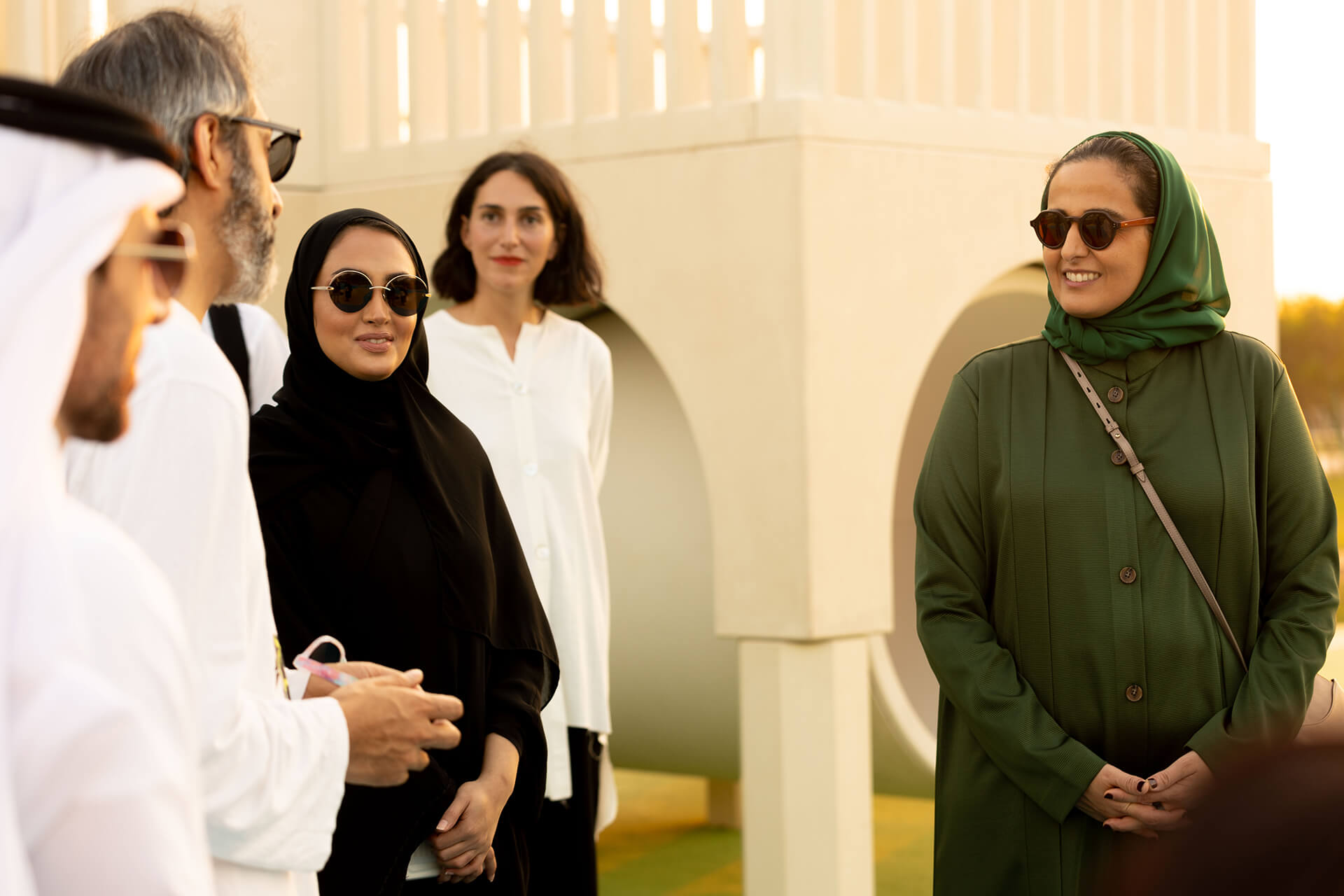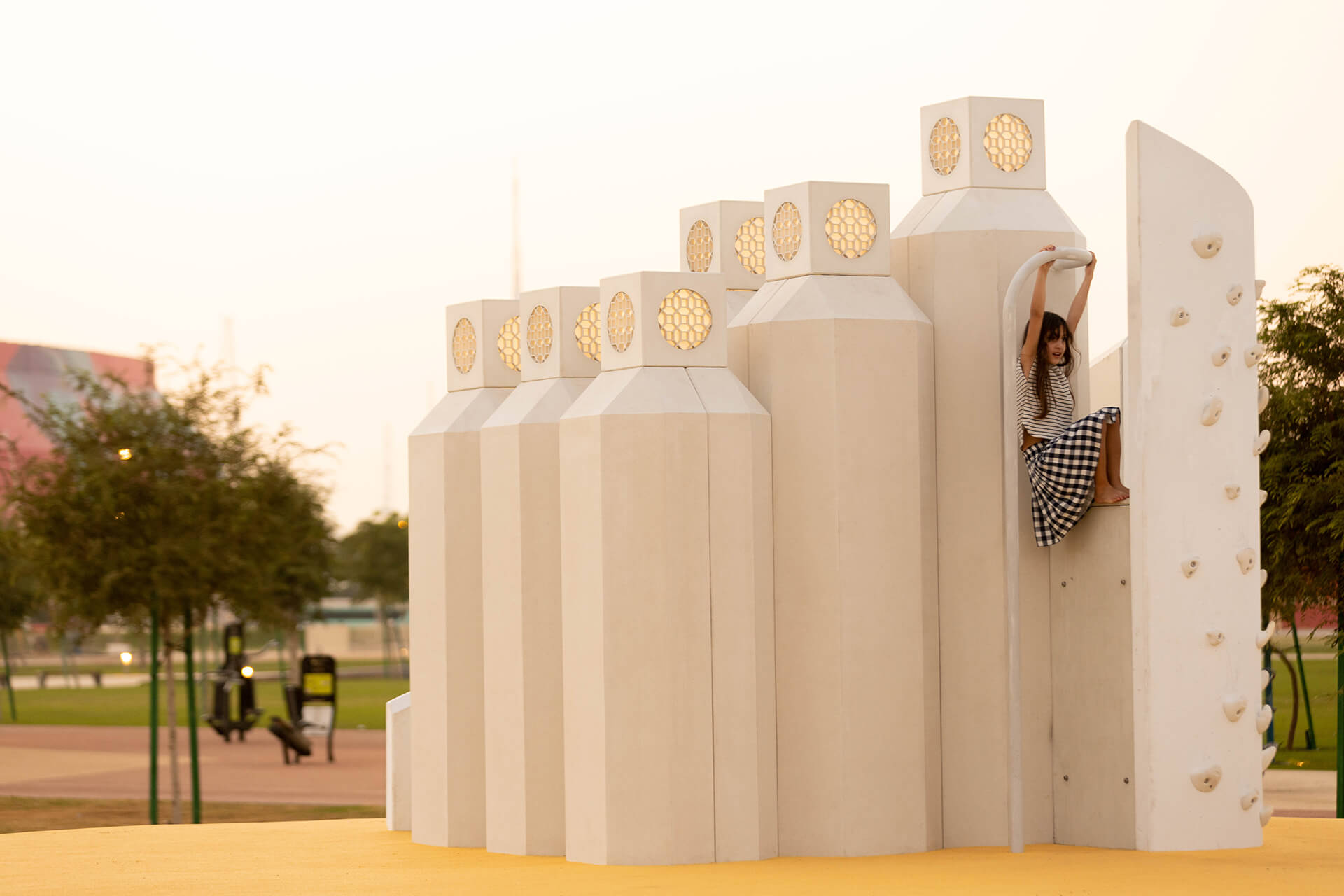Art Mill Museum’s ‘MANZAR’ offers a complex view of modernity in Pakistan
by Ranjana DaveNov 29, 2024
•make your fridays matter with a well-read weekend
by Sukanya DebPublished on : Dec 14, 2022
Doha is the global city of the hour, with the ongoing FIFA World Cup being held in Qatar’s capital city. The country is said to be drawing in international visitors amounting to approximately one and a half million, which is over half its own population. In the run-up to the massive global event, Qatar Museums commissioned 40 new public artworks scattered across Doha as well as the rest of the country, including works by Jeff Koons, Olafur Eliasson, Yayoi Kusama, to mention a few reputed global artists involved.
British artist Shezad Dawood responded to the commission with an artwork that takes the form of a monumental playground, titled Doha Modern Playground, at Al Masrah Park. A sprawling miniature city of sculptures that takes inspiration from significant modernist buildings in the capital, the site is intended to be one of play, where children and adults, alike, are invited to interact and engage. Intended to be at 150 per cent of the size of regular playground structures, Dawood plays on the idea of largeness and size as seen through the eyes of children, in whose world everything is slightly bigger, and therefore, exciting.
Drawing from a larger history of modernism in the 20th century that aligns with several colonial nations gaining independence through the decades, Dawood tells STIR about how he finds himself interested in the “seismic changes in how nations begin to see themselves” and how architecture and urban planning become an extension of ideals, and therefore, expansive gestures of independence, nation building and statehood.

Speaking about the significance of the modernist move in Qatar, the artist tells STIR, “In Qatar, you have quite a unique trajectory from a relatively poor country, largely reliant on pearl diving for its economy, through the petrodollar boom and into a modern and independent nation-state, that is so interwoven with urban planning and the reclaiming of the coastline of the Corniche (a waterfront promenade along Doha Bay)... I spent a lot of time working with local architect and architectural historian Fatma AlSahlawi, exploring this key phase of the built environment, that is only belatedly being given due recognition. For example, the National Theatre building has only recently been restored and updated, and my playground adjoins its location, and so is able to signpost its importance, and there are a number of other key sightlines from the playground to the buildings it references along the Corniche.”
Adults accompanying children can find educational material, with the histories of the very buildings and architects being cited in this built playground, as there are QR codes provided for easy accessibility. Designed by the American architect William L Pereira, known for his futuristic architecture buildings, the Doha Sheraton Hotel provided a sensational inspiration for Dawood. "Interestingly enough, later in his career Pereira became very interested in science fiction as a way to imagine the built environment, and this is something that resonates strongly for me as well. I love the idea that cities (rather like maps and territories) are exercises in the imagination; and the best urban design always foregrounds its users, but especially where a sense of play and discovery is involved. If you look at some of the early images of the Sheraton's construction arising from the desert, there is a real sense of a spaceship landing (as well as a building emerging) that borders on the fantastical," he mentions.

The artwork structures replicate well-known playground motifs such as slides, swings, and tunnel pathways, speaking the familiar and simple language of play. Still, the structures are held together with architectural elements derived from modernising structures within the capital city, that were constructed between the years 1962 and 1987, at a time when there were significant shifts in the country’s self-assertion, having gained its independence in 1971. Architectural references include public buildings such as the Qatar National Theatre, Qatar University, and the Central Post Office in Doha, which were built during a period in Qatar history that reflected strides made in terms of public spending, that was realigned with housing, health, education and so on.
Dawood’s playground ensures keeping the respective structures facing the compass directions of their inspirations, so that viewers and children can make the visual reference naturally. The original modernist buildings stand starkly apart from the 21st century dramatic highrises and voluminous structures that mark the age of business and technology. Having been made mostly in glass reinforced concrete or GRC, the artist mentions that he wanted a finish that would resemble the original buildings in their contemporary weathered look that reflects the structures in the imagination of the public.

Speaking to the notion of play that lies at the core of his inspiration for this work, Dawood says, “I have long been an admirer of Isamu Noguchi's playgrounds and his thoughts on play. I think particularly in the public realm this interface between sculpture and playfulness has the potential to unlock public art for audiences in both tangible and tactile ways. Also given that I work a lot with the architectural, and specifically ideas of architecture that connect with histories and processes of decolonisation, there was always a desire to have the playground relate proportionally to the buildings it references, as well as give children the space of a mini-city to explore and let their imaginations loose on.”
by Srishti Ojha Oct 08, 2025
The 11th edition of the international art fair celebrates the multiplicity and richness of the Asian art landscape.
by Asian Paints Oct 08, 2025
Forty Kolkata taxis became travelling archives as Asian Paints celebrates four decades of Sharad Shamman through colour, craft and cultural memory.
by Mrinmayee Bhoot Oct 06, 2025
An exhibition at the Museum of Contemporary Art delves into the clandestine spaces for queer expression around the city of Chicago, revealing the joyful and disruptive nature of occupation.
by Ranjana Dave Oct 03, 2025
Bridging a museum collection and contemporary works, curators Sam Bardaouil and Till Fellrath treat ‘yearning’ as a continuum in their plans for the 2025 Taipei Biennial.
 surprise me!
surprise me!
make your fridays matter
SUBSCRIBEEnter your details to sign in
Don’t have an account?
Sign upOr you can sign in with
a single account for all
STIR platforms
All your bookmarks will be available across all your devices.
Stay STIRred
Already have an account?
Sign inOr you can sign up with
Tap on things that interests you.
Select the Conversation Category you would like to watch
Please enter your details and click submit.
Enter the 6-digit code sent at
Verification link sent to check your inbox or spam folder to complete sign up process



by Sukanya Deb | Published on : Dec 14, 2022
What do you think?